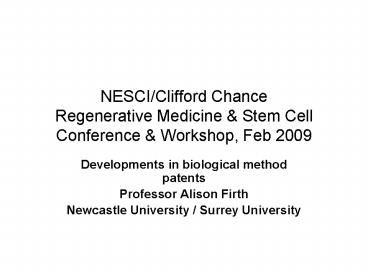NESCIClifford Chance Regenerative Medicine - PowerPoint PPT Presentation
1 / 15
Title:
NESCIClifford Chance Regenerative Medicine
Description:
'1 A cell culture comprising primate embryonic stem cells which (i)...' To a product', cf US 'machine, article of manufacture, composition of matter' ... – PowerPoint PPT presentation
Number of Views:51
Avg rating:3.0/5.0
Title: NESCIClifford Chance Regenerative Medicine
1
NESCI/Clifford ChanceRegenerative Medicine
Stem Cell Conference Workshop, Feb 2009
- Developments in biological method patents
- Professor Alison Firth
- Newcastle University / Surrey University
2
What type of claim was used in WARF?
- Some reports of WARF describe the invention as a
method, but - main claim
- 1 A cell culture comprising primate embryonic
stem cells which (i) - To a product, cf US machine, article of
manufacture, composition of matter - Not a process claim
3
Different!
- How different?
- Europe
- European Patent Convention as amended in 2000
- Draft Community Patent Convention text found its
way into national laws - USA
- Recent petition to Supreme Court process claims
not second class
4
Process claims - less or more rewarding for
patentee than product claims?
- Scientific feasibility/sufficiency
- Methods of medical treatment
- analogies from other areas
- infringement rights
- doctrine of equivalents/ purposive construction
- exhaustion of rights
5
scientific feasibility
- Genentech (TPA) 1989
- Lundbeck ( enantiomer, SSRI) 2008
6
Methods of medical treatment
- EPC Art 53(c) and national equivalents
- surgery, therapy, diagnosis, practised on the
human or animal body - Articles 54(4) and (5) EPC 2000
- Actavis UK v Merck 2008
- Not excluded US and many other countries
7
analogies
- USPTO also more generous m,ethods of doing
business, computer related inventions - Signs of restriction may have implications for
bio - Bilski 2008 CAFC, petition Supremen Court 2009
- method of hedging risk in financial
transactions
8
Bilski test
- not claim a fundamental principle in its entirety
- only a particular application of the fundamental
principle - Method patentable if
- i. tied to a particular machine or apparatus (not
the case in with the Bilski claims under appeal),
or - ii transforms a particular article into a
different state or thing
9
Is Bilski relevant to biological patents?
- Classen Immunotherapies, Inc. v. Biogen 2008
- Petition to SC
- Classen, Cominsky etc demonstrate trend against
process inventions
10
Infringement rights (direct)
- Contrast
- 35 U.S.C. 271 Infringement of patent appears
even-handed as to the nature of the claimed
invention - (a) Except as otherwise provided in this title,
whoever without authority makes, uses, offers to
sell, or sells any patented invention, within the
United States, or imports into the United States
any patented invention during the term of the
patent therefor, infringes the patent. - With
- S 60(1) of Patents Act 1977 and
- Also other European national provisions based on
CPC, eg German s9
11
S 60(1) emphasis, parentheses added
- 60.-(1) Subject to the provisions of this
section, a person infringes a patent for an
invention if, but only if, while the patent is in
force, he does any of the following things in the
United Kingdom strict Plastus Kreativ cf Menashe
under s 60(2) in relation to the invention
without the consent of the proprietor of the
patent, that is to say - - (a) where the invention is a product, he makes,
disposes of, offers to dispose of, uses or
imports the product or keeps it whether for
disposal or otherwise - (b) where the invention is a process, he uses the
process or - he offers it for use in the United Kingdom when
he knows, or it is obvious to a reasonable person
in the circumstances, that its use there without
the consent of the proprietor would be an
infringement of the patent double territorial
requirement the German courts seem to have
found ways of circumventing this difficulty
actual or constructive knowledge
12
S 60(1)(c)
- where the invention is a process, he disposes of,
offers to dispose of, uses or imports any product
obtained directly this has been narrowly
construed in Pioneer v Warner 1997 by means of
that process or keeps any such product whether
for disposal or otherwise. - Similar concept in 35 USC 271(g), which spares
the product of a patented process from
infringement if - (1) it is materially changed by subsequent
processes or - (2) it becomes a trivial and nonessential
component of another product. - TRIPs Art 28
13
Process claims difficult to litigate?
- Astron Clinica, Inrotis et al 2008
- Re infringing activities
- 800 Adept v Murex Securities 2008, US CAFC
- Strict interpretation of claims
- Muniauction v Thomson 2008
- Multiple actors, strict vicarious liability test
14
exhaustion of rights
- Quanta v L.G. Electronics 2008 US SC
- US doctrine applies to process patents
- Murphy v Media Protection Services Ltd 2008
- Ref to ECJ on freedom of services in context of
TV decoders
15
Conclusion
- process claims confer lesser rights than product
claims - Europe and US, but
- Await SC in Bilski































